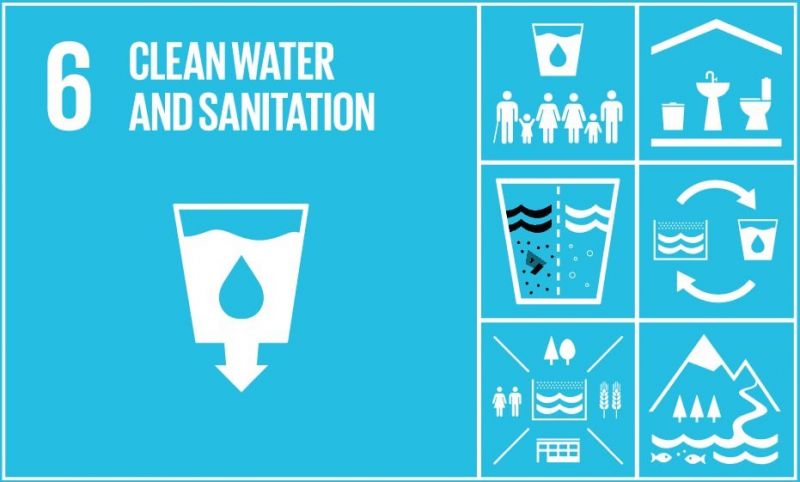My Trial to Understand the UN-SDG 6: Clean Water and Sanitation
Published on by Mahmoud Hussein, Holding Company for water and wastewater - Manager of drinking water quality Department in Case Studies
A trial to understand UN-SDG 6

UN-SDG 6
No one can deny the importance of safe drinking water and adequate sanitation services. However, on the ground, no one can see that, especially in low-income lands. That pushes the concept of “supplying clean and adequate drinking water with the proper wastewater treatment” to be the UN-SDG no. 6.
In Egypt, as a developing country is facing a big challenge regarding UN-SDG no. 6. It has very limited water resources if compared with many other countries in Africa. That is stressing on water quality, quantity, and sanitation as well. In addition, some climatic changes have been recorded to affect the amount and quality of water reaching Egyptian governorates.
Many research articles have addressed extreme events occurring in certain time periods of the year. The highly affected sites with these extreme events were Alexandria and Upper Egypt due to heavy rains. Adding to that, Egypt recently is trying to overcome a great economic crisis. The financial dimension cannot be ignored to achieve sustainable services. Therefore, the international funding agencies should allocate an adequate amount of money for achieving the UN-SDG no. 6 especially in developing and low-income countries.
Not only the political support, financial resources, technical knowledge are the main steering factors but also the good planning, management, integration, and community participation are the complimentary aspects for supplying enough safe water and good sanitation.
Finally, achieving the UN-SDG no.6: Clean Water and Sanitation is not so easy and not so difficult but it needs a global understanding of the importance of achieving that issue. The availability of political support, financial resources, technical knowledge, good planning and management, community participation and overall integration are the key to achieving clean water and adequate sanitation.
Resources and references:
https://sustainabledevelopment.un.org/sdg6
https://www.un.org/sustainabledevelopment/water-and-sanitation/
Badir, M. K., & AlRahman, H. A. (2017). Climate Change and Extreme Events over Dabaa Region, Egypt. In Climate Change Research at Universities (pp. 263-273). Springer, Cham.
Said, M. A., El-Geziry, T. M., & Radwan, A. A. (2012, November). Long-term trends of extreme climate events over Alexandria region, Egypt. In International Conference on “Land-Sea Interactions in the Coastal Zone” Jounieh-Lebanon
Attached link
https://www.linkedin.com/pulse/my-trial-understand-un-sdg-6-clean-water-sanitation-mahmoud-fouad-/Media
Taxonomy
- Drinking Water Treatment
- Resource Management
- Sanitation
- Water & Sanitation
- Sanitation & Hygiene
- Water Supply
- Sanitation & Hygiene
- Drinking Water Managment
- Drinking Water
- Water Resource Management
- Water Sanitation & Hygiene (WASH)
3 Comments
-
Merci Jn- Marius pour cette belle réflexion!
-
French English
Bonjour Mahmoud
Depuis très longtemps maintenant on aborde le sujet de l'eau et de l'assainissement ensemble. C'est une grave erreur même si les deux sont liés. C'est à cause de cela que rien ne fonctionne.
le traitement de l'eau pour la consommation est une problématique
le traitement des eaux usées en est une autre aussi importante que celle de l'eau de consommation mais bien différente.
il est plus facile et à moindre coût financier de produire une eau de consommation correcte. Ce n'est évidemment pas le cas concernant le traitement des eaux usées qui à ce jour est totalement inexistant.
les infrastructures en place pour les eaux usées servent uniquement à transférer les excréments du lieu de la défécation jusqu'au lieu de leur dispersion dans l'environnement sans qu'ils subissent le moindre traitement d'épuration. Leur gestion s'effectue par le principe séparatif de la filtration.
On rejette ainsi dans les milieux naturels de surface un liquide débarrassé des matières en suspension mais pas de la pollution urinaire ni de la pollution chimique.
les matières en suspension finissent tout de même dans l'environnement. Soit directement pour certaines, soit sous une forme plus ou moins déguisée d'un recyclage éventuel.
la problématique de gestion des eaux usées doit être traitée à part entière mais on voit bien que depuis plus de 200 ans aucun système nouveau est venu révolutionner le dispositif en place.
English
Hi Mahmoud
For a very long time now we have been talking about water and sanitation together. This is a serious mistake even if both are related. That's why nothing works.
the treatment of water for consumption is a problem
the treatment of wastewater is another important as that of drinking water but very different.
it is easier and cheaper to produce good drinking water. This is obviously not the case regarding the treatment of wastewater, which to date is totally non-existent.
the existing sewage infrastructure only serves to transfer faeces from the place of defecation to the place where they are dispersed into the environment without any treatment being carried out. Their management is carried out by the separative principle of filtration.
In the natural environments of the surface, a liquid freed from suspended matter is rejected, but not urine pollution or chemical pollution.
the suspended solids still end up in the environment. Either directly for some or in a more or less disguised form of a possible recycling.
the problem of wastewater management must be treated in its own right, but it is clear that for over 200 years no new system has revolutionized the system in place. -
Dear Mahmoud, actually water solutions already exist to solve all water crisis and meet SDG#6 objectives; "BUT" there are many economical interests to manage water crisis keeping the crisis business alive; regards.